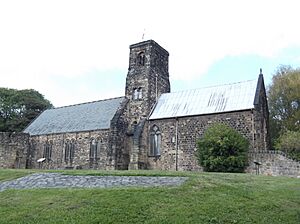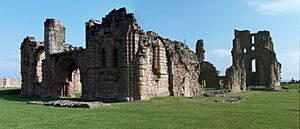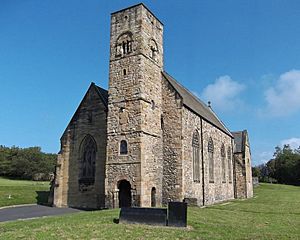List of monastic houses in Tyne and Wear facts for kids
This article is about the monastic houses in Tyne and Wear, England. Monastic houses were places where groups of people, like monks or nuns, lived together. They followed special religious rules. These places were very important in medieval times. They were centers for learning, prayer, and helping the community.
Contents
Famous Monastic Houses
Jarrow Priory
Jarrow Priory was home to Benedictine monks. It was first built around 681 or 682 by Saint Benedict Biscop and King Egfrid. This priory was very important for learning and culture.
Sadly, Jarrow Priory faced many attacks. It was raided by the Danes in 794 and destroyed around 867. It was also burned down in 870. Later, William the Conqueror destroyed it again in 1069.
The priory was rebuilt and refounded in 1074. It became a smaller house, or "cell," connected to Durham Cathedral. The priory was officially closed in 1536. Today, parts of St Paul's Church stand on the foundations of the old monastery.
Tynemouth Priory
Tynemouth Priory was a Saxon monastery. It was home to both monks and nuns. It is believed to have been founded after 653 by King Oswald. Nuns from other areas came here for safety during Danish raids.
Like Jarrow, Tynemouth Priory was completely destroyed by Danish invaders between 865 and 875. It was later rebuilt in the 10th century. In 1083, the monks moved to Durham Cathedral.
The priory was refounded around 1083 or 1085. It became a Benedictine priory linked to St Albans Cathedral. The ruins of Tynemouth Priory are still a famous landmark today.
Wearmouth Abbey
Wearmouth Abbey in Monkwearmouth was another important site for Benedictine monks. It was founded in 674 by Saint Benedict Biscopius. This abbey was known for its beautiful architecture and its large library.
Wearmouth Abbey also suffered from attacks. It was destroyed by Danish raids around 867. Later, Malcolm III, the King of Scotland, destroyed it again in 1070.
The abbey was refounded in 1074 or 1075. It became a smaller "cell" in 1083. The abbey was closed in 1536. Today, St Peter's Church stands on the site of the original abbey.
Monastic Houses in Newcastle-upon-Tyne
Newcastle-upon-Tyne was home to many different types of monastic houses, especially friaries. Friars were like monks, but they often lived in towns and worked more directly with the public.
Austin Friars
The Augustinian Friars had a house in Newcastle-upon-Tyne. It was founded before 1291 by Lord Ross. This friary was closed in 1539. Later, parts of the site were used as a military storehouse. Today, the Holy Jesus Hospital, which is a museum, stands where the friary church once was.
Blackfriars
The Dominican Friars had their house, known as Blackfriars, founded around 1239 or 1260. It was closed in 1538. The surviving buildings of the cloister (a covered walkway) were later used by different companies and as homes for the poor. Today, Blackfriars has been restored and is used as a restaurant, workshops, and a tourist center.
Friars of the Sack
The Friars of the Sack had a house founded in 1267. This order was quite small and was closed down in 1307. Their house was then given to the Carmelite Friars.
Greyfriars
The Franciscan Friars Minor, Conventual, also known as Greyfriars, had a house founded before 1237. They were closed in 1539. There was also a group of Observant Franciscan Friars who moved there in 1498 but were closed in 1534.
Trinitarians
The Trinitarians founded their house in 1360. It was built by William Wakefield on a site that used to belong to the Carmelite Friars. This house was closed in 1539. It was also known as St Michael or Holy Trinity, and sometimes as Acton's Hospital.
Whitefriars
The Carmelite Friars were known as Whitefriars. Their first site was founded before 1262. They moved to a new location in 1307 because the new town wall divided their old site. This new location was the former house of the Friars of the Sack. The Whitefriars house was closed in 1545 or 1546. The remaining buildings were taken down in the 1960s.
Other Newcastle Monastic Sites
- Newcastle-upon-Tyne Monastery (?): There were stories of a very early monastery here, but there is not much proof for it.
- Newcastle-upon-Tyne Priory: A group of Benedictine monks from Evesham Abbey started a priory around 1073. However, they moved to Jarrow in 1074.
- Newcastle-upon-Tyne St Bartholomew's Priory: This priory was home to Benedictine nuns. It was founded before 1086 and possibly refounded before 1135. It was officially closed on January 3, 1540.
See also




